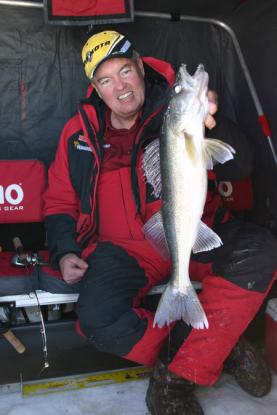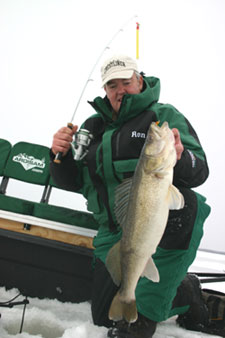 Early ice gets all the hype and for good reason, but that’s ancient history. By late January we’re already into mid winter, and with it comes plenty of good solid opportunities for hard water walleye anglers. The First part of the mid winter season can best be described as run and gun, with the later being more of a set up and stay put scenario. At the early stages walleyes can be expected to be active enough to be caught when you do find them, not so much later on. Then it’s more a matter of slowing down and digging in and being in the right place doing the right things when they finally decide to bite.
Early ice gets all the hype and for good reason, but that’s ancient history. By late January we’re already into mid winter, and with it comes plenty of good solid opportunities for hard water walleye anglers. The First part of the mid winter season can best be described as run and gun, with the later being more of a set up and stay put scenario. At the early stages walleyes can be expected to be active enough to be caught when you do find them, not so much later on. Then it’s more a matter of slowing down and digging in and being in the right place doing the right things when they finally decide to bite.
“Run and gun” means lots of moves, lots of holes drilled, and covering plenty of real-estate until you find the hottest action. Rarely are you able to set up, sit down, and stay put. It’s great when it happens but more often than not it takes quite a few moves to get the job done. Now’s the time for exploring and investing some time and effort to find the heaviest concentrations of fish. The thing is things change, and walleyes won’t always set up where they did last year or the year before. Last years hot spot might be ice cold this season, and you really you can’t be sure until you check it out for yourself.
January temps can make every likely looking spot accessible, and includes the offshore middle of the lake variety. A deep hump or reef that finally has enough safe ice to get to is what we’re talking about and it’s the early bird that gets the worm. The first anglers to get to a hot spot typically get in on the hottest action and the rest that follow are fighting over leftovers. Deep is a relative term and could be ten, twenty, or even thirty feet deep. A reef with a combination of deep and shallow structure is a great option because you can check it all out, and maybe at the same time. With a jigging rod and a tip up you can work the shallow water with the set rig while you jig the deep, or visa versa. Jigging is big a part of finding fish and is why the best ice anglers almost always have a jigging rod in their hand. The snap up and flutter back action of a jigging spoon mimics a dying bait fish and creates the illusion of an easy meal, and walleyes are into easy.
 With a jigging bait like Northland Tackle Buck-Shot Rattle Spoon tipped with a minnow head and a good depth finder you can use the snap and flutter technique and soon see if you’re barking up the wrong tree. Even when walleyes are lethargic they’ll usually come in at least for a look at the spoon, and when they do they’re easy to see. On my Humminbird Ice-55 they’ll show up as thick red marks, and the thicker the better. Thick and red means big, and you really can get a good idea of how big a fish is by the thickness of the return. On the other hand without the zoom and target separation of the Ice-55 multiples of small fish can meld into one, giving you the wrong impression and maybe keeping you in the wrong area much too long. Small fish really don’t tell you much as they can be everywhere. If you’re constantly catching small fries don’t stay and expect them to get bigger. Chances are it will stay that way and you’d probably be better off making a move shallower or deeper or to another area altogether, until you make contact with the size fish you’re really after. Really big fish on the other hand will often show up among smaller adults and suddenly there.
With a jigging bait like Northland Tackle Buck-Shot Rattle Spoon tipped with a minnow head and a good depth finder you can use the snap and flutter technique and soon see if you’re barking up the wrong tree. Even when walleyes are lethargic they’ll usually come in at least for a look at the spoon, and when they do they’re easy to see. On my Humminbird Ice-55 they’ll show up as thick red marks, and the thicker the better. Thick and red means big, and you really can get a good idea of how big a fish is by the thickness of the return. On the other hand without the zoom and target separation of the Ice-55 multiples of small fish can meld into one, giving you the wrong impression and maybe keeping you in the wrong area much too long. Small fish really don’t tell you much as they can be everywhere. If you’re constantly catching small fries don’t stay and expect them to get bigger. Chances are it will stay that way and you’d probably be better off making a move shallower or deeper or to another area altogether, until you make contact with the size fish you’re really after. Really big fish on the other hand will often show up among smaller adults and suddenly there.
When you’ve been catching decent sized fish and the super sized mark shows up it can get plenty exciting and is time to pay extra attention to what you’re doing. A key is not to overwork them and use a gentler less aggressive technique when you have the attention of what could be a real trophy.
Too much action can scare a big fish off but a tiny bump with the rod tip followed by a dead still hold can really turn them on.
Later on in the season when things start to slow down try working what you’ve found much more thoroughly. Instead of spending twenty or thirty minutes on fresh cut holes and moving on you might have to dig in and wait them out. By now minnows suspended bellow floats become more effective, as does the softer big fish jigging technique. Working prime time is also key and includes the period just before and just after dark. If you set up and don’t stick it out you might miss the whole deal, so it would be a good idea to be prepared. That means good lighting, staying warm, and the ability to get back off the ice safely. A Humminbird 917c with G.P.S. mounted to the dash of my sled makes that job a whole lot easier and a whole lot safer. With the big screen and the ability to display high definition maps along with the plot trail you can see where you’ve been and how to get back and I’m never leaving home without it. See you on the ice.










